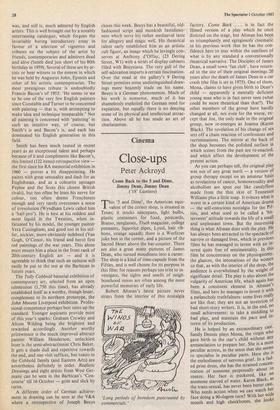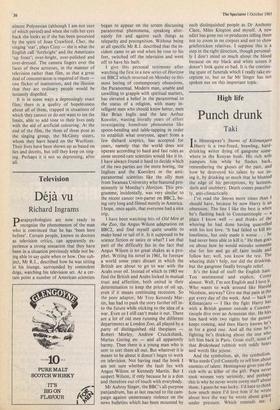Cinema
Close-ups
Peter Ackroyd
Come Back to the 5 and Dime, Jimmy Dean, Jimmy Dean ('18' Lumiere) This '5 and Dime', the American equi- valent of the corner shop, is situated in Texas; it stocks saucepans, light bulbs, plastic containers for food, postcards, Brasso, sunglasses, Truth magazine, college pennants, liquorice pipes, Lysol, hair rib- bons, orange squash; there is a Wurlitzer juke box in the corner, and a picture of the Sacred Heart above the bar-counter. There are also a great many pictures of James Dean, who turned moodiness into a career. The shop is a kind of time-capsule from the Fifties, and is well chosen for its purpose in this film: for reasons perhaps too trite to in- vestigate, the sights and smells of neigh- bourhood stores are often among the most powerful memories of early life.
Robert Altman's latest picture never strays from the interior of this nostalgia
'Long periods of boredom punctuated by commercials.' factory. Come Back . is in fact the
filmed version of a play which he once directed on the stage, but Altman has been so triumphantly and egregiously cinematic in his previous work that he has the con- fidence here to stay within the confines of what is by any standard a conventionally theatrical narrative. The Disciples of James Dean, a small town 'fan club', have return- ed to the site of their original meetings 20 years after the death of James Dean in a car crash (the film is set in 1975). One of them, Mona, claims to have given birth to Dean's child — apparently a mentally deficient young man who is in fact never seen (what could be more theatrical than that?). The other members of the group have hardly changed at all, not even for the worse, ex- cept that Joe, the only male in the original group, now re-emerges as Joanna (Karen Black). The revelation of his change of sex sets off a chain reaction of confessions and recriminations. The mirror at the back of the shop becomes the polished surface in which scenes from the past are re-enacted, and which affect the development of the present action.
As you can perhaps tell, the original play was not of any great merit — a version of group therapy except on an amateur basis as revelations of cancer, homosexuality and alcoholism are spun out like candyfloss made from the thin skin of Tennessee Williams plus a little soap. It evinces what is worst in a certain kind of American drama — the self-conscious nostalgia for the rif- ties, and what used to be called a 'bit- tersweet' attitude towards the life of a small and unpleasant town. But the interesting thing is what Altman does with the play. He has always been attracted to the spectacle of narrow or damaged lives, which in previous films he has managed to invest with an in- terest quite free of sentimentality. In this film he concentrates on the physiognomY, the glances, the intonations of the women so that, as with the interior of the shop, the audience is overwhelmed by the weight of significant detail. The play is also about the vulgarity of American life, which again has been a consistent element in Altman s films, and here he manages to invest it with a melancholy truthfulness: some lives really are like that; they are not an invention of bad short-story writers. It is, in the end, no small achievement: to take a middling to in-
terest play, and maintain the pace and n- terest of its production.
He is helped by an extraordinary cast. Sandy Dennis plays Mona, the virgin who gave birth to the star's child without any annunciation to prepare her. She is a most peculiar actress, in the sense that she seems to specialise in peculiar parts. Here she Is the embodiment of nervous grief. In a fad- ed print dress, she has the strained concen- tration of someone perpetually about to sneeze. Her face is puckered, like an anemone starved of water. Karen Black, as the trans-sexual, has never been better cast. Who needs action when we can watch her face doing a 90-degree turn? With her wide mouth and high cheekbones, she looks
almost Polynesian (although I am not sure of which period) and when she rolls her eyes back she looks as if she has been possessed by the spirit of Joan Crawford. Cher, the singing 'star', plays Cissy — she is what the English call 'forthright' and the Americans `up front'; over-bright, over-polished and over-dressed. The camera lingers over the faces of these actresses, in the manner of television rather than film, so that a great deal of concentration is required of them one flicker of inattention, and the illusion that they are ordinary people would be instantly dispelled.
It is in some ways a depressingly exact film; there is a quality of hopelessness about all of them, trapped in situations of which they cannot or do not want to see the limits, able to add tone to their lives only with the aid of artificial colouring. At the end of the film, the three of them pose as the singing group, the McGinty sisters, whom they have heard on the Wurlitzer. Their lives have been shown up as based on lies and deceits, but still they keep on sing- ing. Perhaps it is not so depressing, after all.







































 Previous page
Previous page